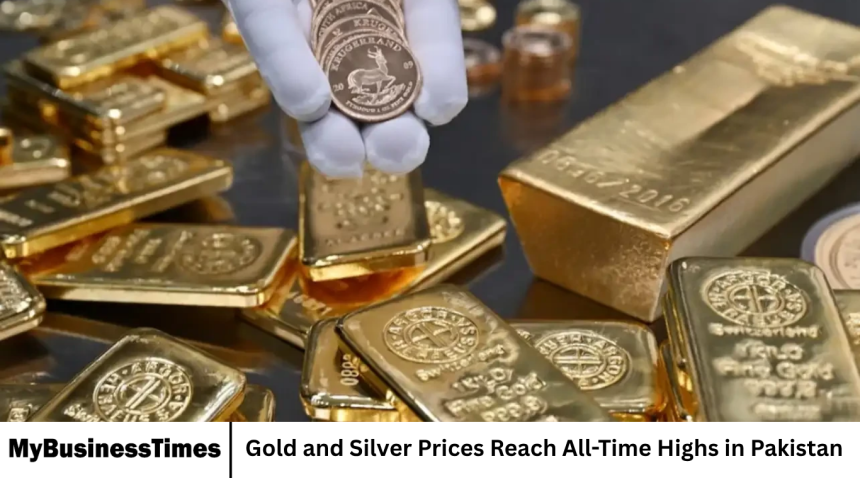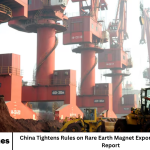Gold and silver prices in Pakistan have reached new record highs, reflecting both global market movements and domestic economic pressures. Rising inflation, currency depreciation, and global uncertainties have made precious metals the preferred choice for investors seeking financial stability. The recent surge has affected jewelry markets, traders, and consumers across the country, while also highlighting broader economic challenges facing Pakistan.
Global Trends Driving Precious Metal Prices
The rise in gold and silver prices is not limited to Pakistan. Internationally, gold prices have surged due to growing demand from investors and central banks. The uncertainty caused by geopolitical tensions, global inflation, and concerns about slow economic growth has led many to view gold and silver as safe-haven assets.
The ongoing global conflicts and economic instability have caused major fluctuations in the value of major currencies, including the US dollar. Since gold prices often move inversely to the dollar, a weaker dollar tends to drive gold prices higher. Silver, which is both an investment and industrial metal, has also gained from rising demand in electronics, solar panels, and other green technologies.
Pakistan’s Economic Context
Pakistan’s economy is currently facing several challenges, including inflation, a weakening rupee, and rising import costs. The country’s dependence on imports for raw materials and energy has further fueled price increases across multiple sectors. As a result, gold and silver have become popular investment options for individuals seeking to protect their savings from the falling value of the currency.
The local gold market closely follows international rates, but the impact of the Pakistani rupee’s depreciation against the US dollar amplifies the rise in domestic prices. This combination of international and domestic factors has made precious metals more expensive than ever before.
Rising Demand for Gold as a Safe Asset
Gold remains a symbol of wealth and financial security in Pakistan. Many people consider it a reliable asset that retains value even in times of economic crisis. With inflation at high levels and the stock market showing uncertainty, demand for gold has risen sharply among investors and ordinary citizens alike.
The cultural significance of gold, especially in weddings and other traditional ceremonies, adds to its demand in the local market. Despite high prices, jewelry buyers continue to purchase gold for personal and ceremonial use, while investors see it as a shield against economic instability.
Silver’s Growing Popularity
While gold attracts the most attention, silver has also seen a significant price increase. Silver’s dual role as both an industrial metal and an investment asset has made it particularly attractive. In Pakistan, silver jewelry, utensils, and ornaments are widely used, and its lower price compared to gold makes it more accessible to the general public.
Silver’s demand is also being supported by global industrial use. As the renewable energy and electric vehicle industries expand, the need for silver in technologies like solar panels and batteries continues to grow. This industrial demand contributes to price increases worldwide, including in Pakistan.
Impact on the Jewelry Market
Jewelry traders and goldsmiths in Pakistan are feeling the effects of rising prices. While demand for gold jewelry remains strong during wedding seasons, higher prices have forced many consumers to reduce their purchases or switch to lighter designs.
Traders report that some customers are turning to silver jewelry as a more affordable alternative. Others are postponing their purchases, hoping for prices to stabilize. Despite these adjustments, the gold trade remains a vital part of Pakistan’s economy, providing employment and business opportunities in cities like Karachi, Lahore, and Peshawar.
Role of the Pakistani Rupee
The declining value of the Pakistani rupee has been one of the biggest drivers of record-high gold and silver prices. Each time the rupee weakens against the dollar, imported goods become more expensive, including precious metals.
As the rupee continues to face pressure due to trade deficits, foreign debt, and limited foreign reserves, gold prices in Pakistan are likely to remain high even if global prices stabilize. This makes gold not just a luxury item but also a form of financial protection for many households.
Investor Behavior and Market Reactions
Investors in Pakistan are increasingly turning to gold and silver as reliable stores of value. The volatility in stock markets, uncertainty about real estate investments, and declining interest rates on savings accounts have made precious metals more appealing.
Many people are now purchasing small gold bars, coins, or jewelry as a form of long-term investment. Traders have also noted a rise in online gold investment platforms, making it easier for people to buy and sell gold without visiting physical markets.
Effects on the Broader Economy
While rising gold and silver prices reflect growing investor confidence in precious metals, they also highlight underlying economic weaknesses. The surge in demand for gold indicates a lack of trust in other investment options and a sense of uncertainty about the future of the economy.
Higher gold prices can also lead to an increase in the country’s import bill, putting further strain on foreign exchange reserves. The government faces the challenge of balancing economic recovery efforts while managing inflation and maintaining currency stability.
Global Central Bank Actions and Their Influence
Global central banks, including the US Federal Reserve, play a major role in determining gold and silver prices. Interest rate decisions, inflation control measures, and monetary policy directly affect global commodity markets.
When interest rates are low, the opportunity cost of holding gold decreases, making it more attractive for investors. Similarly, during times of inflation or political instability, central banks tend to increase their gold reserves, driving prices higher.
In recent years, several countries have been increasing their gold holdings as a hedge against financial uncertainty. This global accumulation has contributed to the sustained rise in prices.
Comparison with Previous Records
The current surge in gold and silver prices surpasses previous records set in earlier years. Analysts note that the combination of global instability, currency weakness, and inflation makes this rise more significant. In contrast to earlier periods of high prices driven by temporary market speculation, today’s rise reflects deeper economic realities.
Public Sentiment and Market Response
Public response to the record prices has been mixed. Some consumers are taking advantage of the high rates to sell old jewelry and make profits, while others express concern about affordability. For many families, gold is not just a luxury but also a cultural and emotional investment, and rising prices have made it harder to maintain traditions tied to gold ownership.
Traders have reported fluctuating market activity, with increased selling during price peaks and cautious buying as customers wait for stabilization.
Government and Policy Considerations
The Pakistani government and financial authorities are aware of the impact of rising gold and silver prices on consumers and the economy. While the government has limited control over global prices, it can influence domestic conditions through monetary and fiscal policy.
Efforts to strengthen the rupee, stabilize inflation, and attract foreign investment are essential to bring balance to the gold market. Authorities may also explore strategies to regulate the gold trade more effectively, ensuring transparency and preventing illegal imports or hoarding.
Future Outlook for Precious Metals
Experts believe that gold and silver prices in Pakistan will remain high in the near future, driven by global and domestic factors. Unless inflation is brought under control and the rupee stabilizes, there is little chance of a significant drop.
In the long term, prices may adjust as the global economy recovers and interest rates stabilize. However, gold’s reputation as a safe-haven asset ensures it will continue to play a key role in investment portfolios. Silver, with its growing industrial applications, may also see continued demand.
Frequently Asked Questions
Why are gold and silver prices rising in Pakistan?
Prices are rising due to global inflation, geopolitical tensions, and the depreciation of the Pakistani rupee, which increases import costs.
How does the Pakistani rupee affect gold prices?
A weaker rupee makes imported goods, including gold and silver, more expensive, directly increasing domestic prices.
Is now a good time to invest in gold?
Gold remains a safe-haven investment during economic uncertainty, but investors should monitor price trends and market stability.
Why is silver becoming more valuable?
Silver’s industrial use in electronics, renewable energy, and electric vehicles is boosting demand, raising its global value.
How are rising prices affecting jewelry buyers?
Higher prices are causing buyers to opt for lighter jewelry designs, delay purchases, or switch to silver alternatives.
Will gold and silver prices fall soon?
Experts expect prices to stay high in the short term due to economic challenges, though long-term stabilization may occur with improved global and local conditions.
Conclusion
The record-high prices of gold and silver in Pakistan are a reflection of global economic uncertainty, local inflation, and currency depreciation. For many, these metals remain trusted sources of stability in times of financial turmoil.
While the rise offers opportunities for traders and investors, it also poses challenges for consumers and policymakers. The situation underscores the need for stronger economic management, stable currency policies, and diversified investment options. In a time of uncertainty, gold and silver continue to shine as symbols of both wealth and security.









